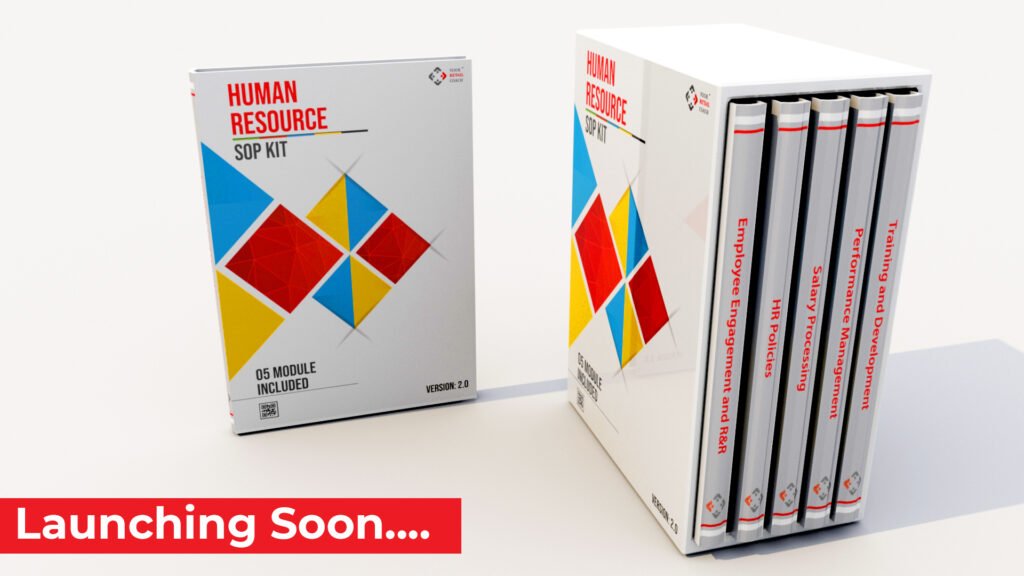SOP for Human Resource (HR) Department
Standard Operating Procedures (SOP) Manual for Human Resources (HR) Department
The activities of the HR department determine how the human resources of an organization are managed from recruitment to retirement. How the HRM operations are managed has a bearing on manpower availability (recruitment, allocation, succession planning, promotions and transfers), training and development, payment of wages and salaries, employee performance, employee motivation and morale, etc. If the processes and operations of this department are not efficient, the overall HRM will be no better and this will affect the entire enterprise.
For example, an incorrectly executed recruitment exercise could result in the hiring of misfit candidates. This will further affect the work of other departments where such recruits would be placed. This is avoidable if there is a sound recruitment process in a place defined by planned and mapped procedures. Similarly, for various other HR activities, the processes and operations can be defined using SOPs. SOPs can play an affirmative role in defining, streamlining, and mapping the HR processes and operations of an organization. Sometimes large companies also prefer to hire the services of top HR consultants to design SOPs and the HR manual for them.
In this article, we will explain a wide range of benefits of having standard operating procedures for an HR department.
Recruitment
The recruitment process should be flawless as this is the channel through which you are adding a valuable asset to your organization. In other words, a good recruitment process can help ensure that the right people are hired for the right job. Everything should be in proper order and coherent with the organization’s goals and mission. This is what every mentor in any professional HR strategy consulting class preaches.
There’s a series of requirements that goes into planning and executing a recruitment process. This includes specific information on manpower requirements, job analysis report, identifying the pool of resources, preliminary screening, conducting tests and interviews, scheduling interviews, salary negotiations, and issuing appointment letters. This entire process can be easily mapped with SOPs. By having well-defined and mapped SOPs, the recruitment process could be made strategic and more aligned with the business goals and the rest of the organization. It will also increase the effectiveness and efficiency of the recruitment process.
On‐Boarding and Induction
On-boarding is the time when an employee is formally made a part of a company after being hired and acquainted with his or her new work environment. This is also when recruits complete the official joining formalities. They are introduced to the organization, the work culture, HR policy manual, their superior authorities and colleagues, workplace policies and procedures manual, the office, the canteen, and so on.
Again, on-boarding is something that should not be treated as an informal tour of the office meeting people and seeing places or be left to self-study of the workplace policies and procedures manual. It should be planned to detail to avoid any subjectivity. There should be a definite sequence in how the on-boarding activities are carried out. And thus, the need for SOP arises.
For instance, there should be a defined timeframe for completing the documentation or paperwork formalities (say on day one). On day two, the recruits could be introduced to their immediate reporting authorities or departmental colleagues. For self-help and self-reference of the recruits, the HR manual or the HR policy manual is also handy.
Training and Development
All the life coaches and top HR consultants iterate that one’s performance is determined by the training he or she underwent. Training is a determining factor in employee performance. It imparts the necessary knowledge, skills and expertise required for a job or a project or an organization. It is also important for companies to look into that their employees are growing professionally. This calls for various development programs.
In many big companies, there are hundreds of new hires that undergo training every year with multiple batches, different training programs, host of trainers, centre arrangements. Apart from that HR also needs to identify the trainees, coordinate with the in-house trainers or the training centres, prepare the training schedules, ensure necessary formalities are completed at every level, oversee the training programs, issue training completion certificates, and so on.
Without SOPs, managing all these activities to complete a training cycle could be a herculean task. If all the required tasks are identified, logically sequenced, and defined with details, it will become easier for the HR team to carry out the training function systematically.
Performance Mapping & Appraisals
For employees to deliver the performance expected of them and achieve the performance-related objectives, they must know the KPIs and KRAs.
Everyone gives in their best efforts and expects a good hike in salaries or even get a promotion at the end of the evaluation period. But how are these decisions made?
If an employee did not find a performance appraisal report satisfactory, what answers would HR or reporting authority have?
The answer is PMS consisting of KRAs, performance scorecards, KPIs, the methods of measuring performances, etc. A good PMS should be able to identify the excelling areas of performance as well as the areas of improvement. There should be no scope for subjectivity and bias in how performances are measured.
SOPs can be more than instrumental in designing a PMS. There has to be a basic procedure to be followed in designing the KRAs and KPIs for each role irrespective of the difference in content. The organizational policies and principles pertaining to employee management also need to find a place here.
Exit Process
The exit process involves aspects like processing of resignation letter, exit interviews to be conducted, full and final settlement from finance, departmental clearances, handing over and taking over, farewell event, etc. From company to company, the exit formalities may vary. But it is better to have a well-documented exit process.
SOPs are important here because there are several activities involved which need to be executed in order while adhering to company policies. There are often multiple departments involved and the entire exit process needs to be mapped passing from one department to another. For example, the finance department needs to take the necessary approval from HR before initiating the full and final settlement. HR can give such approval when the conditions defined in the SOP are met. Again, the rules may vary from company to company, but it is important to have these rules incorporated in the form of SOPs.
A smooth exit process not only helps in timely completion of the required formalities but it also creates a good image of a company’s HR in the industry which can also help a company get referrals from former employees.
Payroll Process
Payroll can be a complicated and bulky task for HR of any company. With an increasing number of employees, the task gets more complex. This is a reason why many companies prefer to outsource their payroll function. The entire process cannot be automated because the salary bills are usually hefty and actions might be irreversible. Even with ERP, there is still a requirement for human intervention and coordination. But even an ERP system needs to be customized according to a company’s planning, policies, and practices covering approvals, calculations and disbursements.
The payroll process can be defined to detail using SOPs. Starting from the trigger (which usually is a date) to salaries being disbursed going through inputs, approvals, and calculations can be mapped in a step-by-step sequence using SOPs. ERPs are extremely useful for the digital processing part but as stated earlier the ERP also needs to be customized based on the SOPs being followed or intended to be followed by a company. Without ERP, SOPs could be the sole operational roadmap for HR to execute the payroll process.
Expense Management
Policies and procedures pertaining to employee expense management are important for settling bills. Bills often create rifts in company-employee relations. There could be issues on the authenticity of bills, sometimes even on the morality of expenditure made, delays in submitting bills for reimbursement, delayed reimbursements and so on. These differences are not healthy in any work culture. Therefore, the policies and procedures governing expense management must be unambiguous.
Companies can define the expenditure limits and the areas of expenditure, permitted type of hotel accommodation and type of transportation for different positions, periodical expenditure limits, conditions for special cases, method of calculating the reimbursable amounts, approving authorities, etc. By having wide and well-defined policies and procedures, companies can have a smooth and fair expense management system in place leading to more transparency, less subjectivity and bias, timely reimbursements, and better focus on work for all.
YRC Methodology
We emphasise that if businesses have to become truly process-driven in a competitive sense they must not only incorporate SOPs but also ride on digital processes. We go beyond designing SOPs in pen and paper and seek to achieve SOP-ERP/HRM integration.
With SOP design as one of our flagship services, our experience tells us to make procedures look simpler in practice and implementation.
Easy-to-use HR SOP templates shall be defined to ensure that being process-driven is not an uphill task for the HR department of any business enterprise.
Human Resource SOP Playbook

GET NOTIFIED FIRST AFTER LAUNCH
Benefits of Standard Operating Procedures (SOPs)
Get Advice for HR Department SOPs
Related Blogs
Making the most out of the festive season shopping: A Customer Perspective for Retailers
Decoding the Festive Shopping Spree For us, as customers, the festive season is a licence to spend. The vibes of festivity ushers with joy and a sense of celebration. This elevated mood often turns into an enhanced willingness to spend and indulge in shopping. It is a...
Mitigating Business Risks in Retail
Spotting the Swirls Sailing the stream of retail is canopying between opportunities on the surface and risks as the current of that stream. If the bad swirls are not spotted in advance, it can turn things undesirable. While big brands grapple with issues like lapses...
How Retailers are Enhancing Customer Experience (CX) with Hyper-Localisation
Hyper-localisation is an alignment strategy that helps retail brands and businesses mould into the requirements of a locality-based market environment. Marketing-wise, it helps retailers tailor their value propositions to cover the needs and expectations of highly...





We work only for Visionaries.